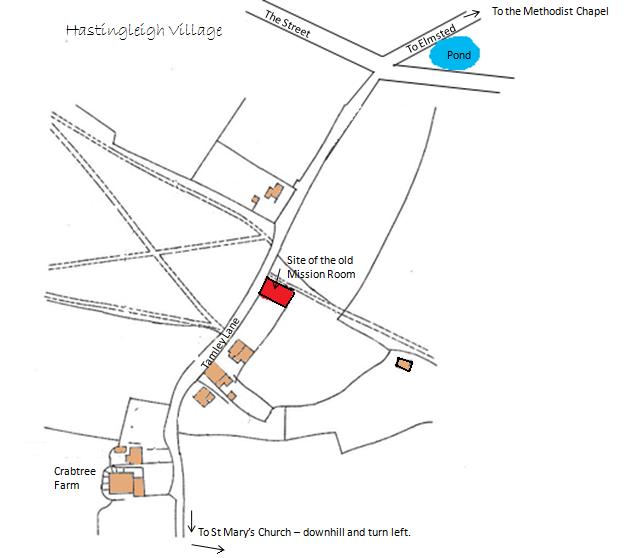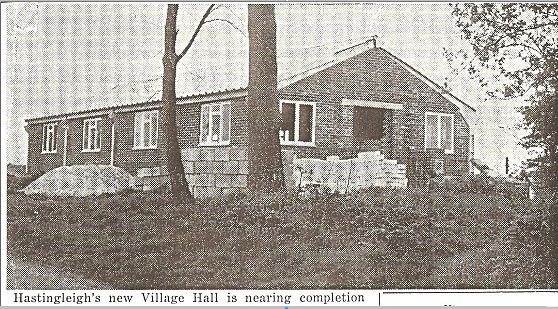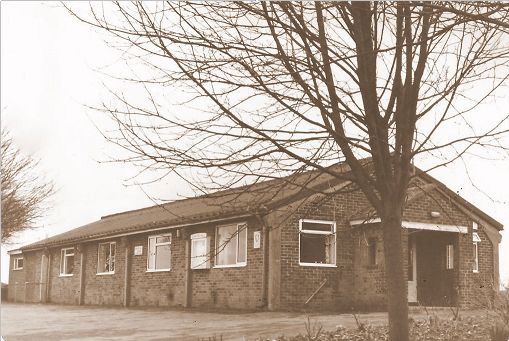Hastingleigh.com A Genealogy Website / One Place Study Contact e-mail

The Mission Room / Old Village Hall
/ Parish Room 1895 - 1960
In 1895, the Reverend Anthony Collett, Vicar of Elmsted and Rector of Hastingleigh,
funded the building of a Mission Room at the top end of Tamley Lane. It was built on
Glebe land (Church land) which had been rented by a Mr Stickles. Its primary purpose
was to provide a place of worship for the elderly residents of Hastingleigh, and the
Evington Lees end of Elmsted Parish, that would be unable to get to their respective
Churches because of the distances of the Churches from their homes, and the difficulty
in reaching them in harsh winters.The Hall was a focal point of village activities for 65 years until it was replaced by the current village hall which opened in 1960.
The small old village hall building survived 2 world wars and hosted a vast array of activities.
It was used as a reading room in its early history, as well as for church meetings and activities. It became a jam factory during the war years, and
hosted Whist drives, Theatrical and Fund Raising events.It was hired by the Youth Club, the Welfare Dept., the Womens Institute, Evington Sports Clubs, Wedding receptions,
and in war time, was the distribution centre for Ration Cards at a rental charge of 15 shillings to the food office.
The responsibility of the hall was held by two trustees, one of the Tappenden family and the incumbent Rector/Vicar of Hastingleigh and Elmsted.
Before WW2 the trustees were Rev. Reuben Coverdale and Mr Cubison Tappenden (aka Mr Q Tappenden), from 1943 the trustees were
Mr G.P.Tappenden and the incumbent Rector of Hastingleigh (Mr Stevens, Mr Hill, Mr Wells and then Mr AE Prior.)
After Mr GP Tappenden's death in Oct 1960 the trusteeship was handed to his widow until the Parish Room was sold. Various members of the
Parish Communities of Elmsted and Hastingleigh were on the Old Hall Committees as secretaries, treasurers, vice-chairmen and so on.In 1948 talks on replacing the Hall with a modern larger building were already underway, though it would be another 12 years before it would
come to fruition. In 1948 an upgrade to the old hall facilities was necessary. And it was registered as the Polling Station for Hastingleigh.
In 1948 the cost to hire the hall was 7/6 [7 shillings and 6 pence] without the use of the Piano, and 10 shillings with the Piano. With a view to
raising revenue to pay for the urgent repairs these rates were increased to 1 Pound. If the hall was being hired for a minimum of 6 occasions in
advance, then a 50% discount was applied.
A questionnaire was drawn up and sent to every household in the two Parishes of Elmsted & Hastingleigh to ascertain people's preferences for
re-building the old hall or building a new hall on a site near the war memorial ,and also to get an idea about how willing the parishioners would
be to undertake the fund raising that would be necessary.
By 1949 it was decided that building a New Hall was the most popular option, though there were some who disliked the idea. Commander and
Lady Findlay of Court Lodge Farm were approached with regard to building the New Hall on land at Evington Lees, which they owned. The Findlays
agreed to sell the land earmarked for the site of the New Hall. The estimated cost for the New Hall (to seat 250 people) was £5000 and half
this sum would need to be raised by the communities of Elmsted and Hastingleigh, in advance of any work done. The rest of the cost would be
covered with a grant from the KEC (Kent Education Committee.)
Meanwhile the Old hall was still needed, and had to undergo several repairs. The windows were broken, the paraffin lamps were dangerous, the old
stove was faulty, the doors to the lavatory needed refitting. All costing money that the Parish could barely spare in the post war era of rationing.
Mr Tappenden from the village stores and several other generous chaps and ladies mucked in to lend their skills to getting the hall fit for purpose.
To avoid confusion with the New Hall fund raising efforts, the old hall or Mission Room was formally renamed The Parish Room in 1949.
The Kitchen roof had a close call in 1950. It needed replacing, and Mr Tappenden offered to supply asbestos sheeting at cost price to cover 17ft x 12ft.
Mercifully they didnt fit and corrugated tin sheets were used instead. The Parish Room committee offered a discount of the hire fees in exchange for
volunteer labour from the men of the Evington Sports Club, to get the new kitchen roof installed. Five Gallons of green paint were bought for the exterior
painting and cream paint for the window wood work.
The window curtains would be made from the old serge drapes which had been used to partition the Parish Room before the war. However it was
discovered that the fabric had past its usefulness and was scrapped. Mrs Tappenden bought 10 yards of new fabric and sewed all the curtains herself.
She donated these free of charge to the Parish Room.
New crockery, jugs and cutlery were bought after a fund raiser, and these were available to be hired by Parishioners. The Cricket Club which played
matches at New Barn farm regularly hired the crockery for use during cricket matches to supply teas to the home and visiting teams. Even the furniture
could be rented to raise funds. A trestle table cost 6d to hire and a card table 3d a day.
The piano was tuned twice a year by Burnages of Ashford, and following their suggestion, it was decided that the Piano would not be for hire outside
the Parish Room.
In 1950, after struggling with paraffin lighting for 55 years, it was decided to raise funds to purchase an electric light engine. This was at a time when
Hastingleigh was still not supplied with electricity. A draw /raffle in honour of the St Ledger was held at the Bowl Inn on 6th September 1950 raising
16 Pounds, and the Evington Dramatic Society were asked to give a percentage of their takings from the next show, to help in the cost of a suitable engine.
An engine was bought for 15 Pounds and it used about 1 gallon of petrol to supply one evenings lighting. However in 1951, reports show the Parish Room
petrol suply kept being stolen. The same year, the Evington Players requested permission for a beam to be erected at the front of the stage, from which to
hang full length stage curtains. 1951 saw the arrival of mains electricity to the village. Mr Tappenden agreed to supply all the equipment necessary for
wiring the hall, at cost price and Mr Chandler and Mr Ron Marsh volunteered their services to wire the Parish Room free of charge.
The Electric Lighting Machine was sold at auction when the mains electric supply took over.
In 1952 fourteen new chairs were donated to the New Hall (which was still not built) and these were on loan to the Parish Room until the New Hall was
completed.1953 Coronation year!! The Parish Room features throughout the celebrations. (click for Newspaper reports and photos)
1954 saw the closing of the Youth Club (to the obvious relief of the Parish Room committee as the Youth Club had been responsible for 3 broken windows
in the previous year.)It was also the year that the Parish Room got its first fire extinguisher.
The next 6 years saw a struggle for funds for urgent repairs to the Parish Room foundations while the greater emphasis of fund raising activity was aimed
in the direction of the New Hall.
In 1960 The New Hall opened. The Parish Room plus 3acre land was sold for 100 Pounds to Mr TH Young. Commander and Lady Findlay offered 4 acres
of land behind the New Hall in exchange for the Youngs field. Mr TH Young agreed to the land being made over to the Evington Sports Club.
At the closing of the Parish Room and winding up of the Parish Room Committee, it was proposed by Mrs Edna Young that some of the funds be used to 
buy an electric clock for the New Hall and with a plaque dedicating it to the memory of Mr George Pibus Tappenden, the trustee of the Parish Room from
1943 to his death in October 1960 in honour of his outstanding contribution to the communities of Hastingleigh and Elmsted. This was done, and the
remaining funds were equally split between the two churches; St Marys Hastingleigh and St James Elmsted.
The Parish Room was used as a general store room for a while and eventually it was pulled down when it became unsafe.
Hastingleigh NEW Village Hall at Evington
This report from the Kentish Express 19 April 1959:
Village Hall Is 100 per cent Local Effort
HASTINGLEIGH villagers have every right to feel proud of their new hall, which is well on the way to completion. Although only the shell
of the building is up, this is regarded as an achievement, particularly as for many months the hall stood like a skeleton waiting for enough money
to buy bricks after the framework and roof had been finished.
Initiative has so far not been rewarded by any form of outside help. Mr Charles Jessel, hall chairman, said "Everything that people now see of our
hall has been done entirely by Hastingleigh itself without one penny of Ministry grants."
As villagers had sufficient courage to go ahead with their building plans, the Ministry of Education refused to consider giving a grant because
application was not made before work began.
Local effort has raised £ 900 and to complete the structure, another £ 200 is needed. Then villagers must face the problem of equipment,
lighting and heating and it is here that they hope for help from the Ministry. Plans for the new hall were made in 1948 when the existing hall was
'outgrown' by the increasing population. One of the organisations delighted to have a new hall are the Evington Players.
At present, the parish hall can seat only 60 and when the Players give performances these have to run for at least three nights to give everyone
a chance to get a seat, but this increases production costs and lessens profit.
Much of the hall has been built by voluntary labour from the very start, when local people lent tractors and labour to clear the site of trees and
undergrowth. During weekends, volunteers laid bricks under the eye of a bricklayer; women have done their share by unloading and sorting bricks,
have mixed cement, and done numerous odd jobs. They are planning to do some painting later. Leader of the volunteers has been Mr Jack Thompson,
manager of a local grocer's shop.
The Village Hall circa 2000 - shows the extended hall and addition porch with newer windows installed

